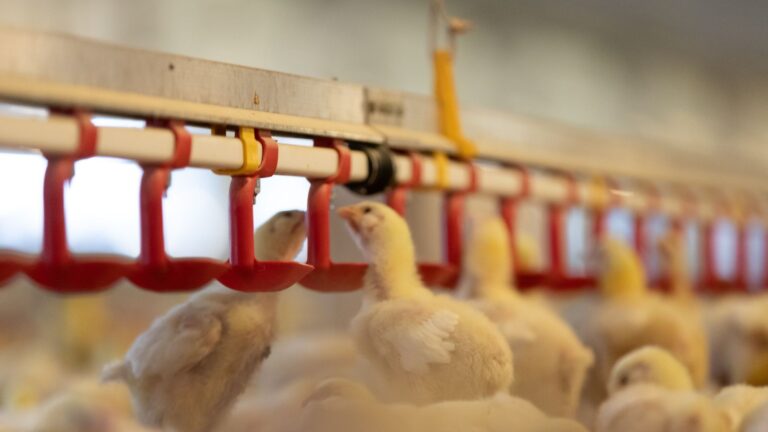How close monitoring of water intake can support early disease detection
By Michael McCreesh, SenseHub Poultry
Water intake is one of the most critical indicators of broiler health, yet it is perhaps often overshadowed by more established performance metrics, such as weight gain and feed conversion ratio (FCR).
While variations can occur naturally in response to feed, environmental conditions and vaccinations, sudden drops in water intake can indicate more serious underlying issues are afoot, such as the onset of viral or bacterial infections, so it is essential that producers act fast.
As more producers embrace precision livestock farming, automation, and real-time monitoring, the range of new technology presents numerous options that promise to transform the way we monitor and assess bird health and performance. It offers an unprecedented level of detail and data at our fingertips.
Driven by consumer demand for higher welfare standards and the increasing value placed on each bird, technological innovations are undoubtedly becoming crucial tools in early disease detection for broiler producers.
But with so many options on the market, focusing on the right metrics is key. Technology is not a replacement for good stockmanship.
Wireless sensors, such as SenseHub Poultry, allow for continuous, real-time monitoring of key parameters like temperature, humidity, CO2, water intake and weight gain to empower stockmen with access to clear-cut outlier bird performance reports, to make more informed management decisions.
The recent hot weather has emphasised the importance of monitoring water intake. In extreme heat (32°C+) older birds initially drink excessively – up to 30-50% more compared to in optimum temperatures.
If the heat becomes too severe, birds can stop drinking altogether, with each fluctuation alerting producers that shed conditions are too hot, or that there are issues with ventilation and humidity.
The first response to a change in water intake, should be for producers to enter the affected shed and observe the birds’ behaviour and demeanour, considering activity levels, and increased mortality rates. It is also important to check for mechanical failures, and issues with feed pans, as without feed, birds naturally will not drink.
If environmental conditions are optimal and feed is accessible, yet water consumption remains low or mortality rates have increased, it’s time to seek veterinary advice.
We have observed a pattern of incidences, where sudden declines in water intake precede the onset of viral infection, in some production cycles we have been monitoring.
On a farm recently, the SenseHub Poultry platform signalled one out of a number of sheds, was experiencing reduced water intake around day 10-11, much below the normal target range.
After receiving an automatic alert flagging the decline, the farmer used the analytics dashboard to identify that environmental conditions across all sheds were adequate for optimal bird performance.
Further inspection of the shed experiencing the significant drop in water intake showed no obvious environmental causes, prompting a call to the vet, who provisionally diagnosed gizzard erosion, but later confirmed adenovirus in the flock which can often result in increased mortality, poor growth rates and uneven bird weights.
As adenovirus can spread vertically (from parents) and horizontally (from direct contact), the farmer was advised to keep a very close eye on the other sheds. When he received a minor water intake alert from another shed, he promptly investigated but gladly this was proven to be due to a recent feed change, with water intakes returning to normal swiftly.
This goes to show how two similar alerts can happen as a result of very different causes or problems, demonstrating the need to interrogate the data and work with your vet still to identify and rectify.
The visual clarity of having real-time water intake trend metrics presented via a dashboard, coupled with tailored alerts, enabled the producer to raise vigilance and respond ahead of progressive clinical signs of infection, and costly implications at processing.
Traditionally, these practical stockmanship steps relied on experience and routine observations, however with rapidly evolving disease risks, data-led technologies can help to strengthen and accelerate the steps required for effective flock management.
As broilers are commonly reared on six-week rotations, something going wrong can lead to considerable liabilities, as demonstrated by the 5.5 million birds lost to Avian Influenza between October 2021 and November 2022.
When UK cases of AI escalated, a clear sign in flocks that cases were developing was massive drops in water intake.
By identifying this pattern through technology, producers were able to promptly initiate biosecurity measures and protocols to comply with regulation.
This approach is becoming increasingly essential, and a major advantage, as the quicker producers act, the better – particularly when it comes to viral infection cases.
Real-time data insights, combined with preventative vaccination and treatment, are crucial for improving welfare and production efficiencies through more informed farm management decisions. This technology also helps combat antimicrobial resistance (AMR), enabling quicker interventions to minimise viral infection and reduce antibiotic use.
While real-time data technology is not a diagnostic tool, it is proving invaluable as an early warning system, helping producers compare conditions across sheds and flocks to identify abnormalities before they escalate into larger problems.
This proactive approach helps protect bird welfare, optimise performance, and reduce the risk of undetected health issues—all crucial in a competitive market.


